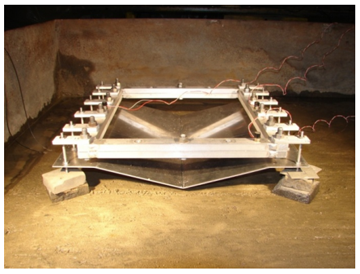![]() Dynamic Effects Laboratory
Dynamic Effects Laboratory
PI: Prof. William Fourney
This laboratory has been supported over the period of the last five years to enhance our understanding of pressure time profiles that vehicles are subjected to when a buried mine detonates and mitigation of underbelly blast effects.
We used small scale simulated vehicle models and subjected them to a given set of blast conditions. We used saturated sand as out test beds and the vehicles were approximately 14 inches by 16 inches in extent. All simulated vehicles were subjected to the detonation of the same size buried charge (4.4 gm) with the same stand-off distance from the sand surface to the bottom of the vehicle.

In the tests, we varied the details of the simulated vehicle (manufacture of the frame and hull, polyuria coating, method of attachment of hull to frame, etc.) and determined, using high speed photography and attached accelerometers, the acceleration, HIC, and jerk levels felt on the frame of the vehicles.
We utilized small scale testing to determine the pressure time profiles acting on plates subjected to underbelly detonations. After conducting a large number of tests (approximately 100 tests), we determined that at any given point on the plate the pressures were not reproducible. However, the pressure at any given point over a large number of tests is predictable within a certain margin. The purpose of this exercise was to determine if the applied pressures obeyed a normal distribution.
It appears that the cumulative distributions of peak pressures can be adequately represented by cumulative normal distributions. For the sets of test conditions considered, the normalized pressure distributions from a range of radii are so similar that they can be grouped. It appears that the normalized peak pressures on the target can be arrayed in two groups that correlate with the local loading mechanism. These loading mechanisms are (1) the soil cap over the explosive hitting the target and (2) material from the crater hitting the target as the crater is being excavated. Over the range of HoT examined, the standard deviations of the normalized pressures increase with an increase in HoT for the radii, where the first mechanism dominates, and the standard deviations of the normalized pressures over the radii, where the second mechanism dominates, are quite insensitive to HoT.
The complete results from this study can be found in “Pressures on Targets From Buried Explosions”, L. C. Taylor, W. L. Fourney, & H. U. Leiste, Blasting and Fragmentation, Vol 4, #3, December 2010, pp 163-192.

